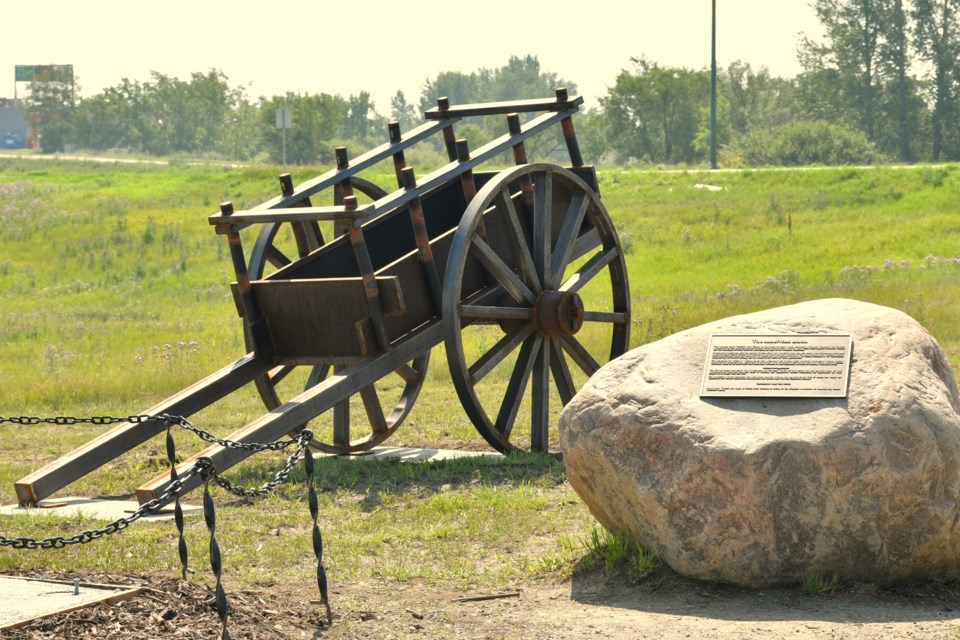MOOSE JAW — A newly installed Red River cart at the Tourism Moose Jaw kiosk is the latest tribute to the ingenuity and legacy of the Métis people on the Prairies — and a proud step toward deeper cultural visibility in the city’s tourism landscape.
Installed recently in partnership with the New Southern Plains Métis Local No. 160, the full-size cart is a custom-built steel replica, constructed to historical specifications based on an 1850 model from the Smithsonian Institution.
“The cart itself came from a set of prints we took from the Smithsonian Institute in the United States,” said Darrell Hawman, president of the Métis Local No. 160. “It was (built) from (plans for) a traditional Red River cart in 1850 and it was built to spec by the welders at Sask Polytech, (led by) a master welder, Rick Thibault. He spent at least a couple hundred hours, I think, on it.”
The wheels, too large to shape in Moose Jaw, were sent to a larger Sask Polytech facility at its Regina campus. “They had to get the steel rounded in Regina in their bigger press,” Hawman said.
While the metal version was made to withstand Saskatchewan’s weather, it mirrors the wooden version on display at the Western Development Museum, which was unveiled earlier this month and constructed using traditional mortise and tenon joinery. Together, the two carts form part of a larger initiative by the Métis Local No. 160 to preserve and promote Indigenous history.
“What will come next is the proper signage for it,” Hawman said.
A commemorative placard from the 1955 Queen’s Jubilee will also be displayed, highlighting Moose Jaw’s historic role as a trail hub for four major routes and a key provisioning point for the North West Mounted Police travelling between Fort Walsh and Fort Qu’Appelle — a journey in which Red River carts played an instrumental role.
Moose Jaw’s position as a major crossroads in pre-railroad Canada underlines the significance of the cart’s new placement at the tourism centre, connecting contemporary visitors to the region’s deep Métis and transport history.
The Red River cart — entirely human- and ox-drawn — served as a vital supply chain across the Prairies in the 18th and 19th centuries, often travelling in long convoys known as “trains.”
“(These trains) would go as high as 1,200 … but usually (travelled) in groups of 30 or 40,” Hawman said, describing how the carts were connected in a daisy chain, with one man controlling around 10 wagons in the convoy.
For Hawman and the Métis Local No. 160, the installation is about more than preservation — it’s about cultural recognition.
“We hope to eventually have an 1850s Métis village as part of a tourist attraction for Moose Jaw,” he said. “It will be one more thing to do while you’re here, to check out the Métis history and (the history of the) First Nations groups (who gathered) in Wakamow.”
He also emphasized the broader contributions of the Métis people to Canada’s economic foundations.
“People have no idea of the economic value that (the Métis people contributed) west of Winnipeg,” said Hawman. “I often say, if St. Louis, MO, was the kickoff to the West in the United States, then Winnipeg was the kickoff to the West in Canada. Prior to the settlement period, 200 or 300 years … (of the) fur, buffalo, and pemmican trade … were done by the Métis people and First Nations.”
A formal dedication ceremony is expected in the coming weeks once signage and cultural protocols are in place.
“It’s an incredible monument for our town,” Hawman said. “Just wonderful.”
The new cart is located at the Tourism Moose Jaw kiosk at 450 Diefenbaker Drive.




